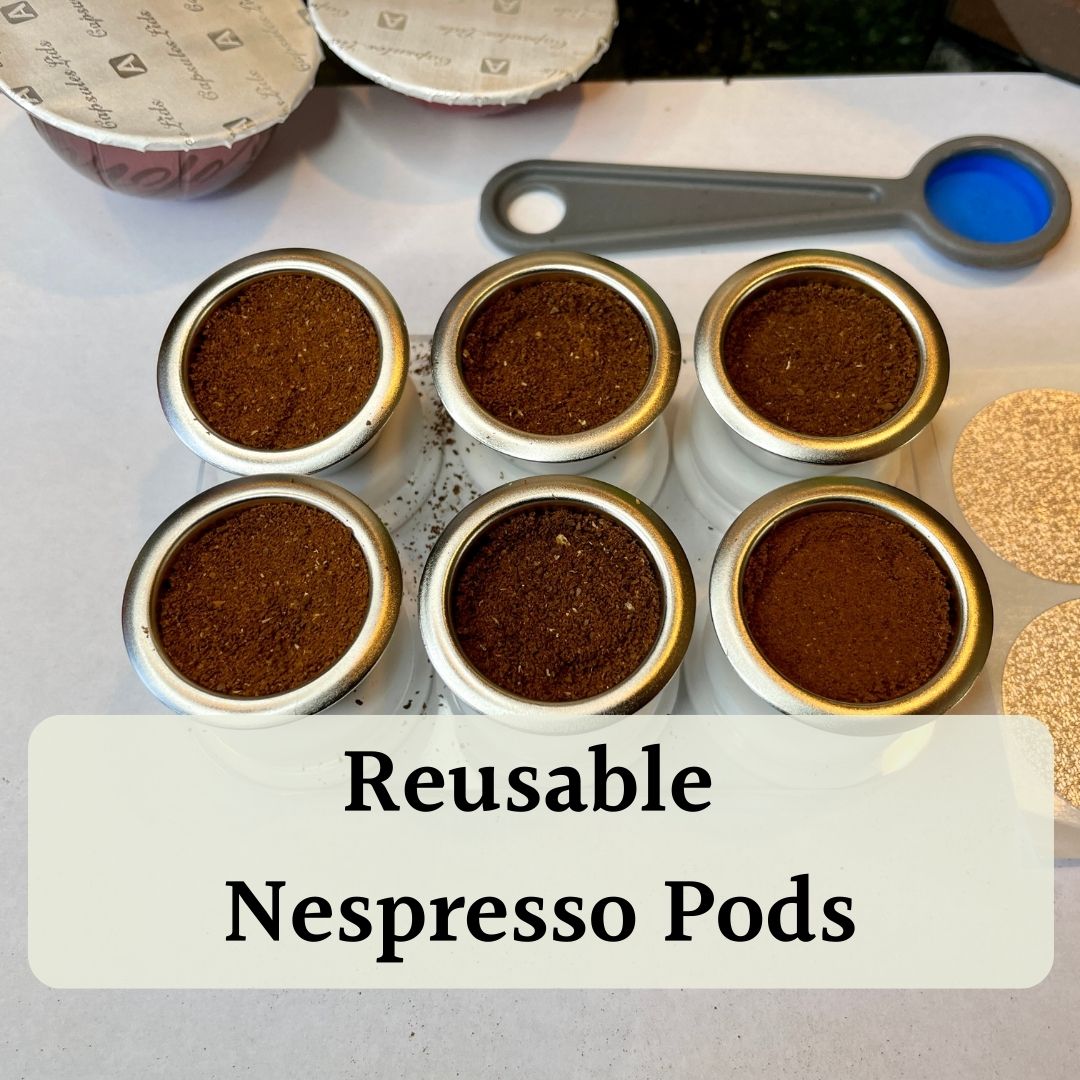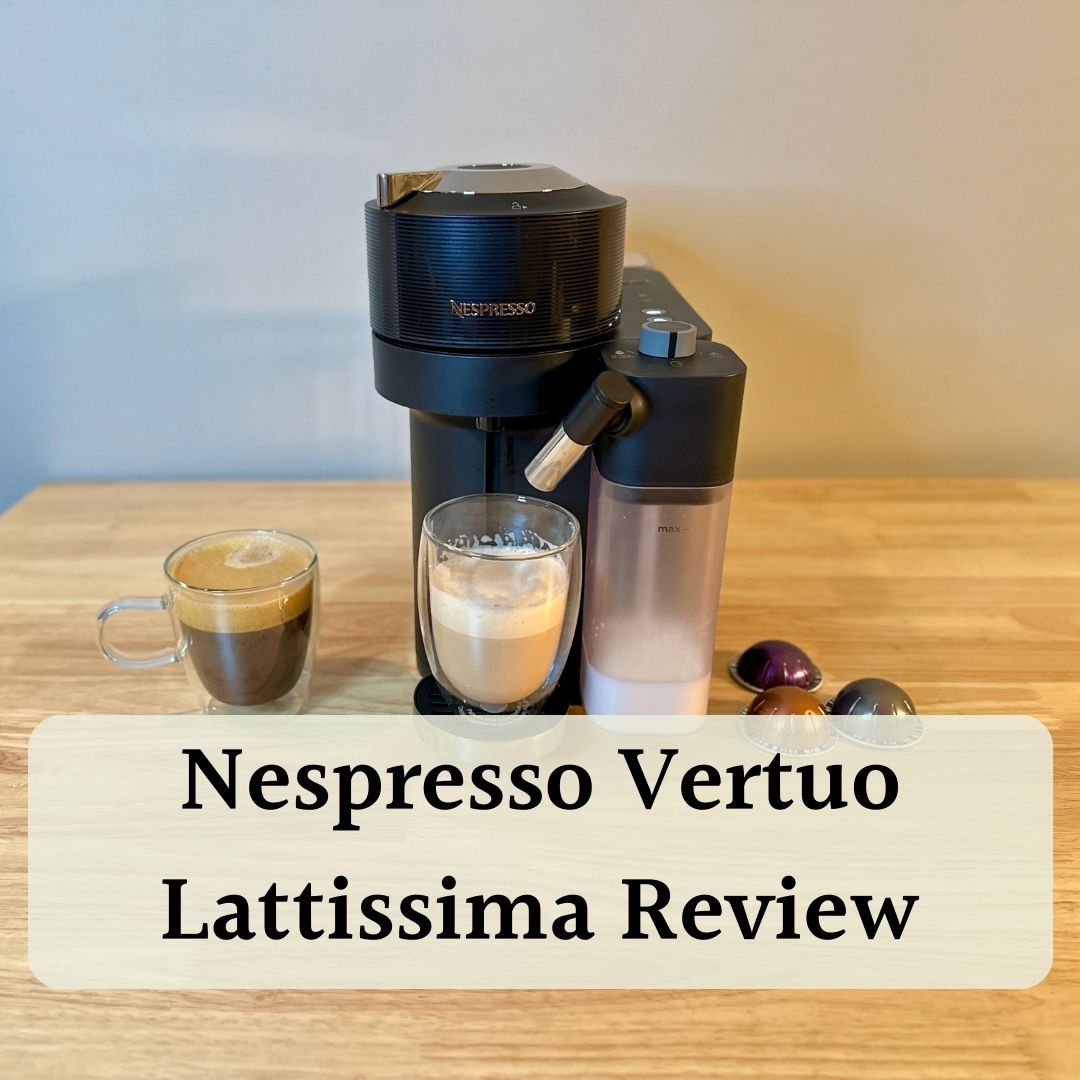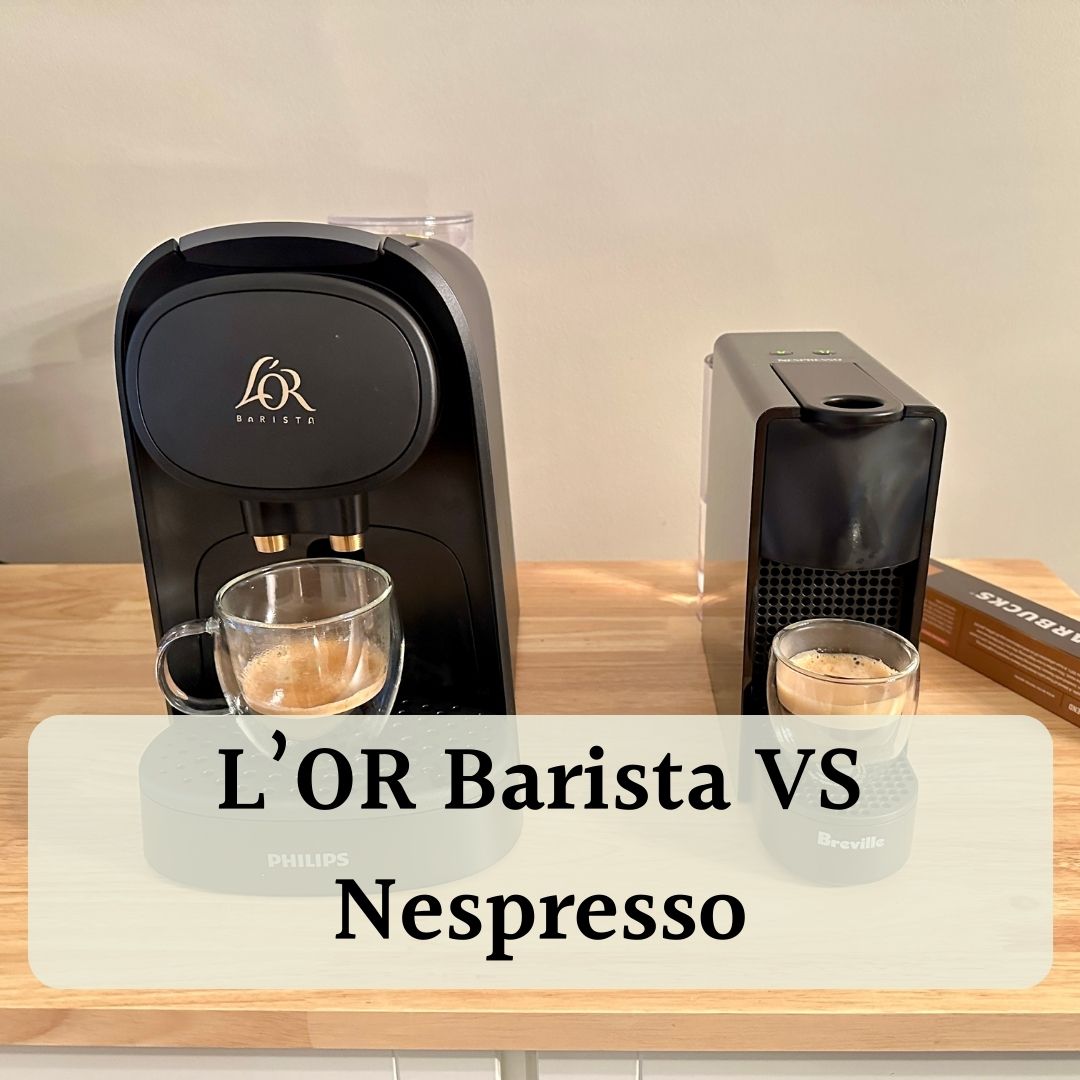Many coffee lovers scoff at Nespresso machines and say that it isn’t real espresso. But, Nespresso machines have found their place with millions of users worldwide.
The biggest difference is Nespresso coffee has a thinner texture and muted taste. Meanwhile, espresso has a pronounced, bold flavor and heavy bold that sticks to the tongue. However, Nespresso is far easier to learn than espresso, and I enjoy the taste of their pods, which is closer to a strong coffee than an espresso.
I’ll compare Nespresso vs espresso machines and explain their similarities and differences, including a taste test. I’ll also explain who’s best suited for each espresso machine, so you can decide on the best coffee device for you.
Comparing Nespresso vs. Espresso
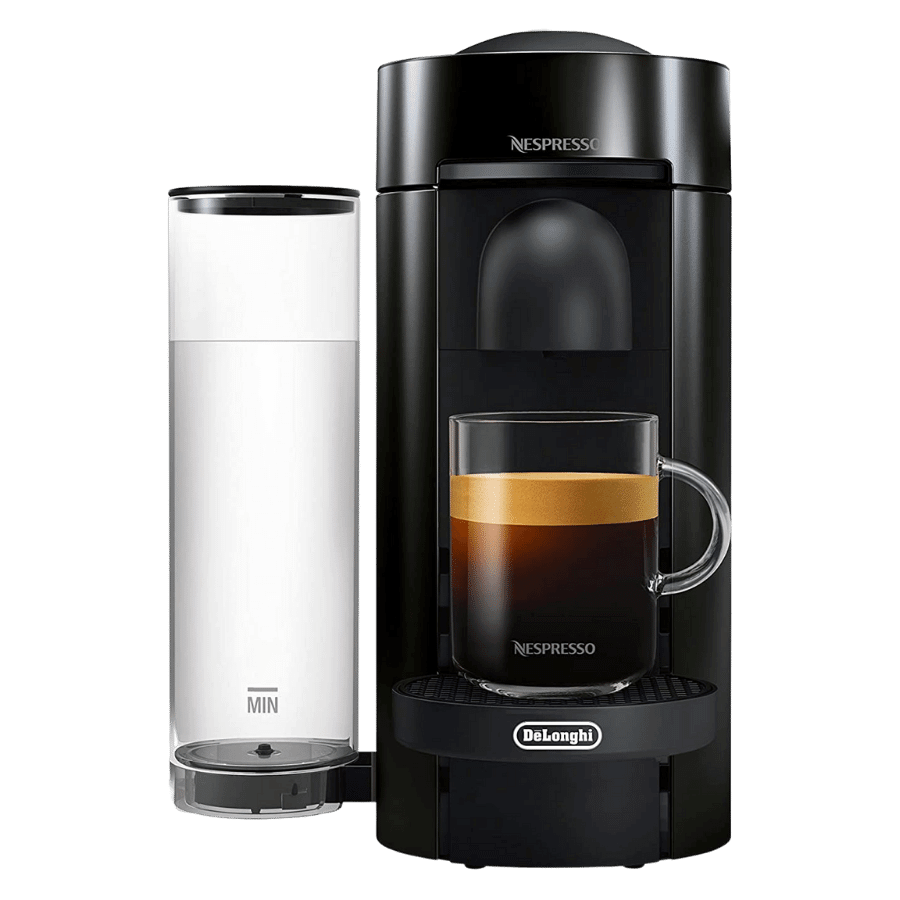
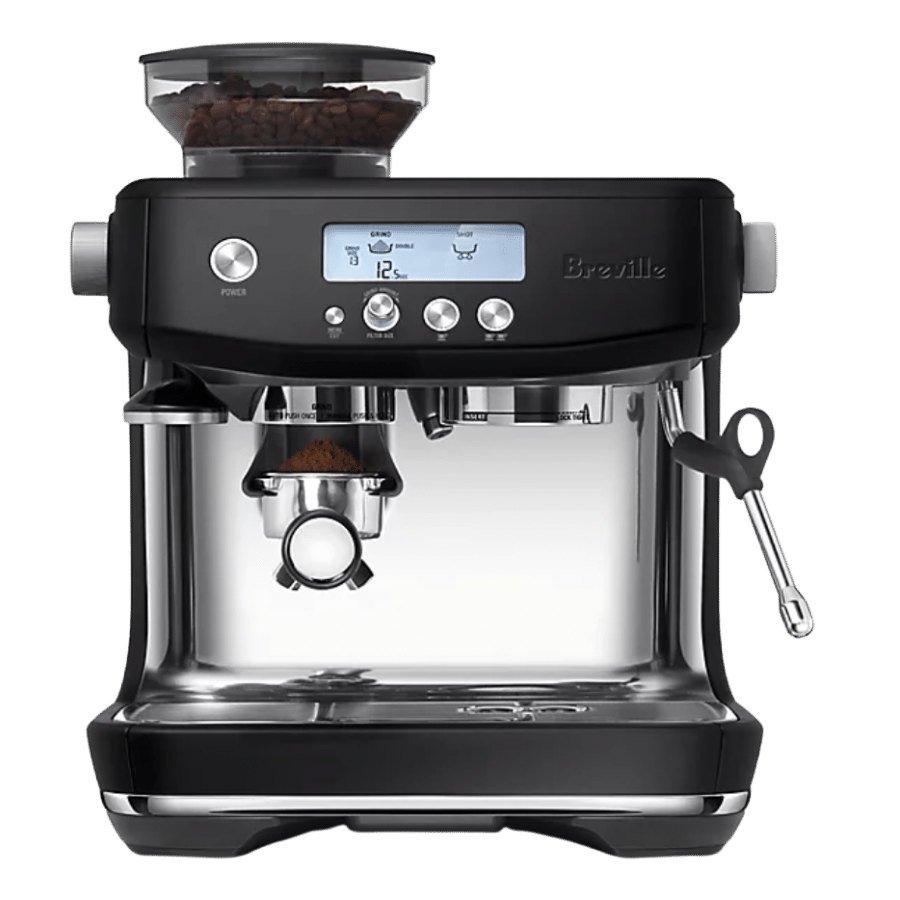
Taste
Overall, Nespresso tastes milder, is less acidic, and doesn’t have the rich flavors of an espresso machine. The traditional espresso flavor is rich, bold, intense, and has a perfect balance of sweetness, richness, and acidity.
The different taste is mainly due to a lower coffee ratio. While a typical espresso machine uses a 1:2 ratio of coffee to water, a Nespresso machine wil get closer to a 1:6 ratio. You can see the difference between two espressos from each machine:
| Nespresso | Breville | |
|---|---|---|
| Coffee in (g) | 7 | 18 |
| Espresso out (g) | 40 | 38 |
| Coffee-to-water ratio | 1 : 5.7 | 1 : 2.1 |
The brewed espresso was almost identical, but the espresso machine used over twice the amount of ground coffee in. This leads to a significantly lower ratio of coffee to water. A lower ratio means the coffee is stronger, which directly influences the texture of the coffee. A true espresso will stick to the tongue with a lingering taste.
A second difference affecting taste is the grind size. Nespresso machines also use a coarser grind size than espresso, where grind size is the largest contributor to taste after bean freshness.
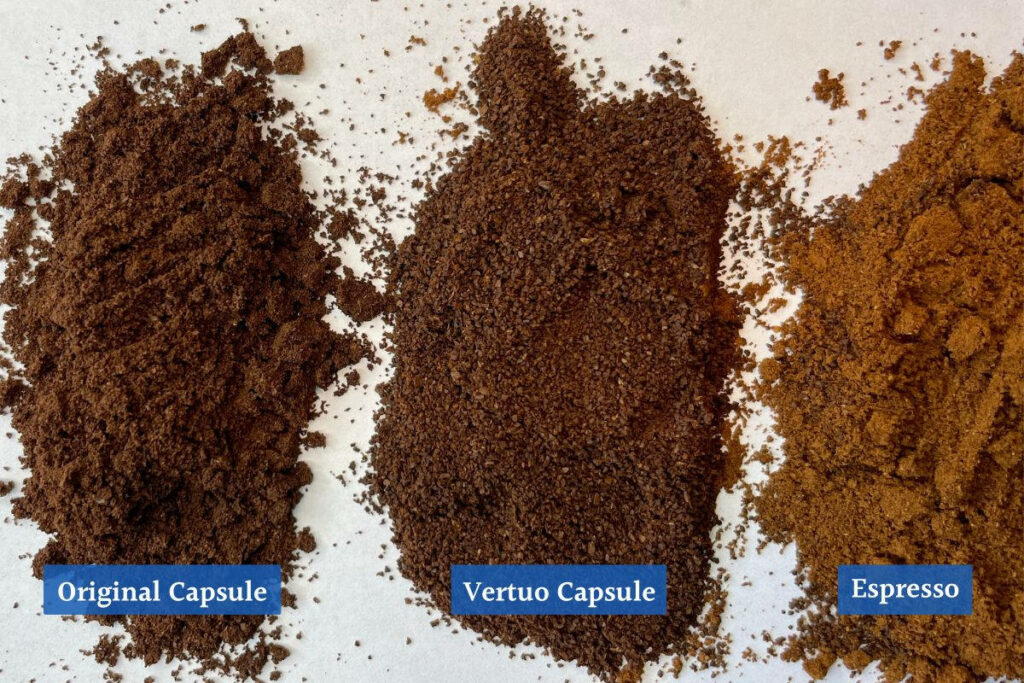
Third, the Nespresso machine brews cooler than a traditional espresso machine. This is certainly true for the Nespresso Vertuo machines, where the brewing temperature was 170-180 Fahrenheit, compared to 200 degrees from my espresso machine.
A coarser grind and lower brew temperature will mute the flavor profile of Nespresso coffee, because those factors limit extraction. That’s why a true espresso has such a strong, almost overpowering taste.
I go through this taste test on our video:
However, taste isn’t given for an espresso machine, because good espresso requires skill and experience. If you’re a beginner barista, there’s a high chance your Nespresso shot will taste better than your first attempts on a regular espresso.
Crema
While taste is the most important, crema is a close second factor when discussing espresso. Crema is a distinct feature of espresso, and it’s the thick foam on top of an espresso, which is created from the high-pressure brewing process for espresso.
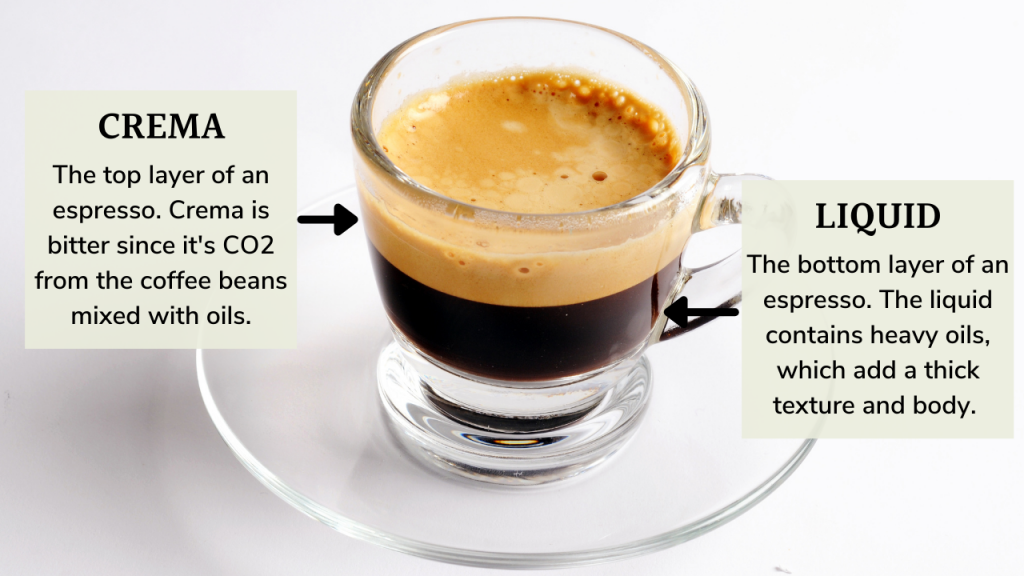
Nespresso crema is bigger and more aerated than typical espresso. This is particularly true for the Vertuo machines which can create crema that can be picked up with a spoon. Even the Original machines create a solid crema that is similar to traditional espresso.
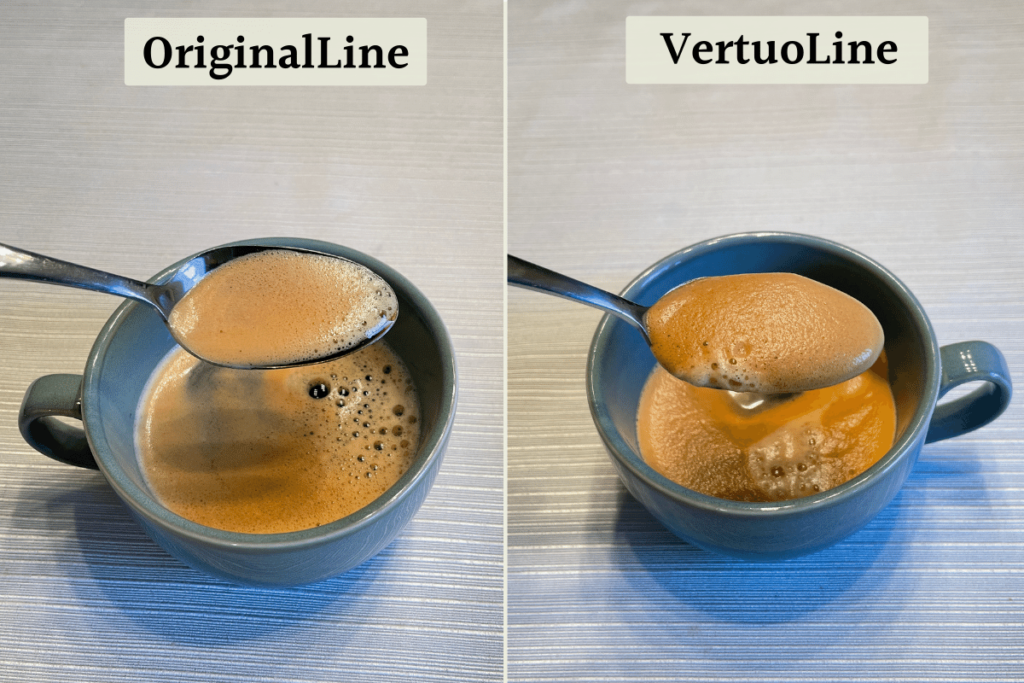
Nespresso makes a great crema on the drinks. In fact, part of the origin story is the inventor of Nespresso, Eric Favre, was inspired by the lever machines creating thick crema in Italy.
Crema makes Nespresso drinks much more aromatic than a typical espresso, as you’ll really notice that first sip. That enhanced aroma is important because your olfactory system contributes highly to our sense of taste. Just try plugging your nose before drinking a coffee and notice how the flavor is weaker.
So crema does help the flavor of Nespresso.
Difficulty and Learning Curve
An average espresso machine has a much higher learning curve than a Nespresso machine.
Espresso machines are harder and take longer to use. The machine has to warm up, then you have to grind the beans, prepare the portafilter, tamp it, and pull a shot.
Chances are, you’ll have to fiddle with the settings — make grind adjustments, add more coffee, tamp, and more. Also, you should clean and wipe down the portafilter and the machine before turning it off.
The entire process of making traditional espresso takes me about three to four minutes in the morning with practice.
On the other hand, Nespresso doesn’t have a learning curve. The machine warms up in about a minute. You insert the pod and press a button. The machine pulls a shot. That’s it.
Nespresso machines are also easier to maintain, and every model has a built-in container for used pods.
If you want a challenge and aren’t afraid of putting in the work, then an espresso machine is a good choice. But, if you want convenience and don’t want to invest time in learning how to use espresso machines, go for a Nespresso one.
Price
In terms of price, Nespresso machines are significantly cheaper compared to espresso machines. Nespresso machines start at just over $100, a fraction of solid espresso machines.
However, Nespresso machines require an ongoing expense — Nespresso coffee pods. The price of these depends on which pods you buy. You’ll spend less money at first, but if you drink a lot of coffee, the price of pods will quickly add up.
Here’s the typical cost over a year:
| Nespresso Vertuo | espresso machine | |
|---|---|---|
| Cost per coffee | $1.10 | $0.75 |
| Annual Cost | $402 | $274 |
| Difference | $128 |
While there’s a decent selection of espresso machines under $200, these are “starter” machines. They don’t produce the same level of espresso as more expensive machines. If you’re a beginner barista and want to get serious, I recommend a budget of $1,000.
If you want an easy option for espresso, a good super-automatic espresso machine will cost at least $1,000. You may find a decent semi-automatic machine for a couple of hundred dollars less, but it’s a much bigger investment than a Nespresso machine. You also may have to buy a grinder, scale, and other espresso accessories.
However, while Nespresso pods are pricy, many third-party manufacturers sell more affordable varieties (for OriginalLine) and you can find reusable pods, so you’ll have room to experiment and find pods you like best.
Also, you’ll probably have to get a separate frother for a Nespresso machine if you want milk-based espresso drinks.
Nespresso Overview
How Does the Machine Work?
Nespresso machine is all about ease of use and convenience. These coffee makers are fully automatic, eliminating almost any chance of human error.
Nespresso machines use specific Nespresso pods to work. The pods are hermetically sealed and contain pre-portioned single-use servings of coffee beans — 5 to 7g of ground coffee. They come in many versions. You can choose between standard, flavored, and decaf capsules.
You insert the Nespresso capsules into the machine and press the brew button. The Nespresso machine pumps water from the water tank. The boiler heats the water in a few seconds. The machine punctures a hole in the capsule and injects hot water through the hole at high pressure.
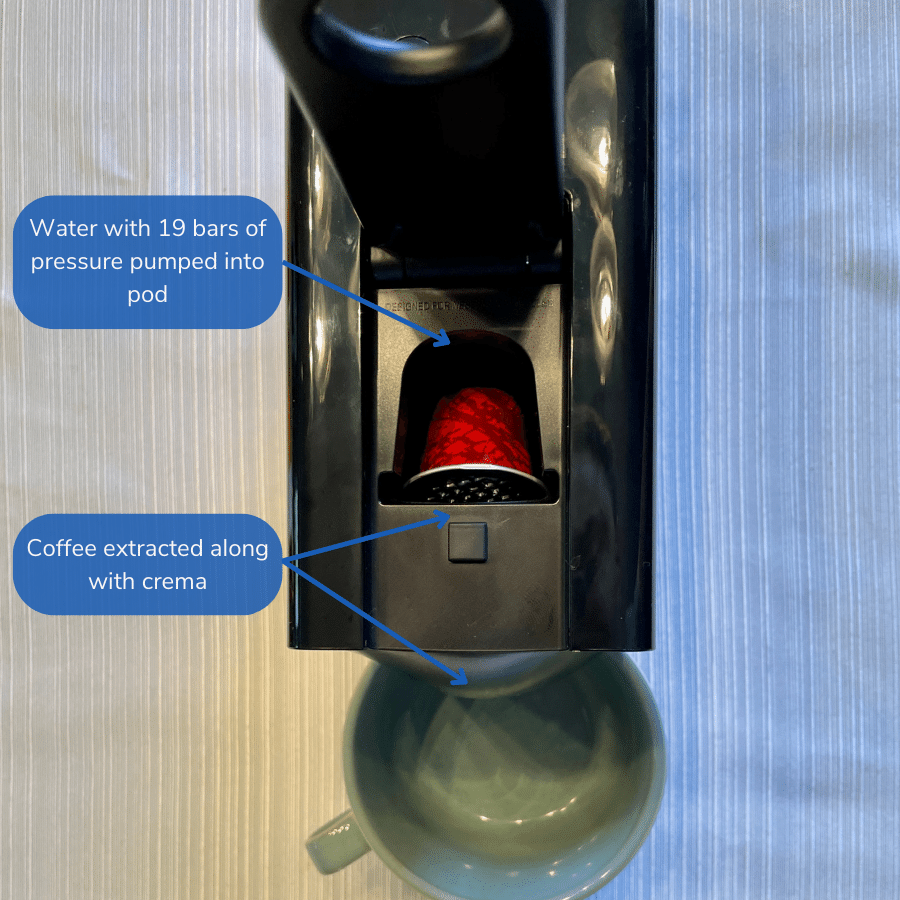
The water goes through the coffee in the capsules and extracts the flavor from the fine coffee grounds. The coffee grounds are dissolved in water and forced out the other end of the capsule as coffee. Nespresso says all their machines can reach 19 bars of pressure, which is enough to give the espresso shot nice crema.
You don’t have to dial in, measure, grind the coffee beans, tamp the puck, and attach the portafilter when using Nespresso machines. All you have to do is insert the pod and press a button.
Nespresso Machines come in two versions: OriginalLine and VertuoLine. The brewing process is different depending on the model you purchase.
Both versions use Nespresso capsules. However, several third-party capsule manufacturers are compatible with either Original or the VertuoLine.
OriginalLine
OriginalLine Nespresso coffee makers use about 19 bars of high pressure to pull espresso coffee. It works like I’ve described above — a needle pierces the capsule, the machine forces hot pressurized water through the ground coffee, and the coffee comes out at the other end of the capsule.
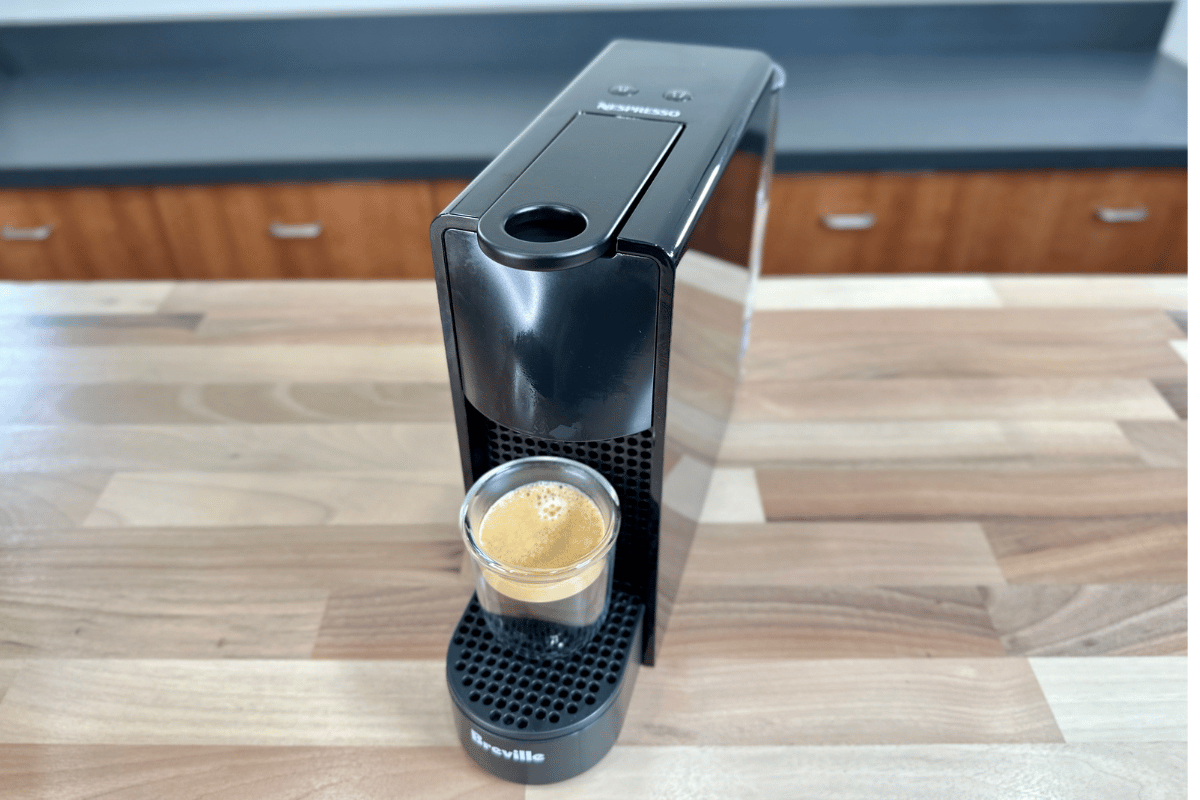
The OriginalLine process is conceptually similar to regular espresso brewing but with more bars and pre-ground coffee pods instead of a portafilter.
These machines brew single or double espresso. Some can even froth milk, but most need a separate milk frother for milk-based espresso drinks. OriginalLine espresso machines are only compatible with OriginalLine capsules.
VertuoLine
Nespresso came up with VertuoLine in 2014 to appeal to the demand for bigger coffee servings.
It works differently compared to OriginalLine. VertuoLine machines use Centrifusion technology, which means the machines use centrifugal force to brew coffee. The pod spins 7,000 times per minute for the best flavor extraction and rich crema.
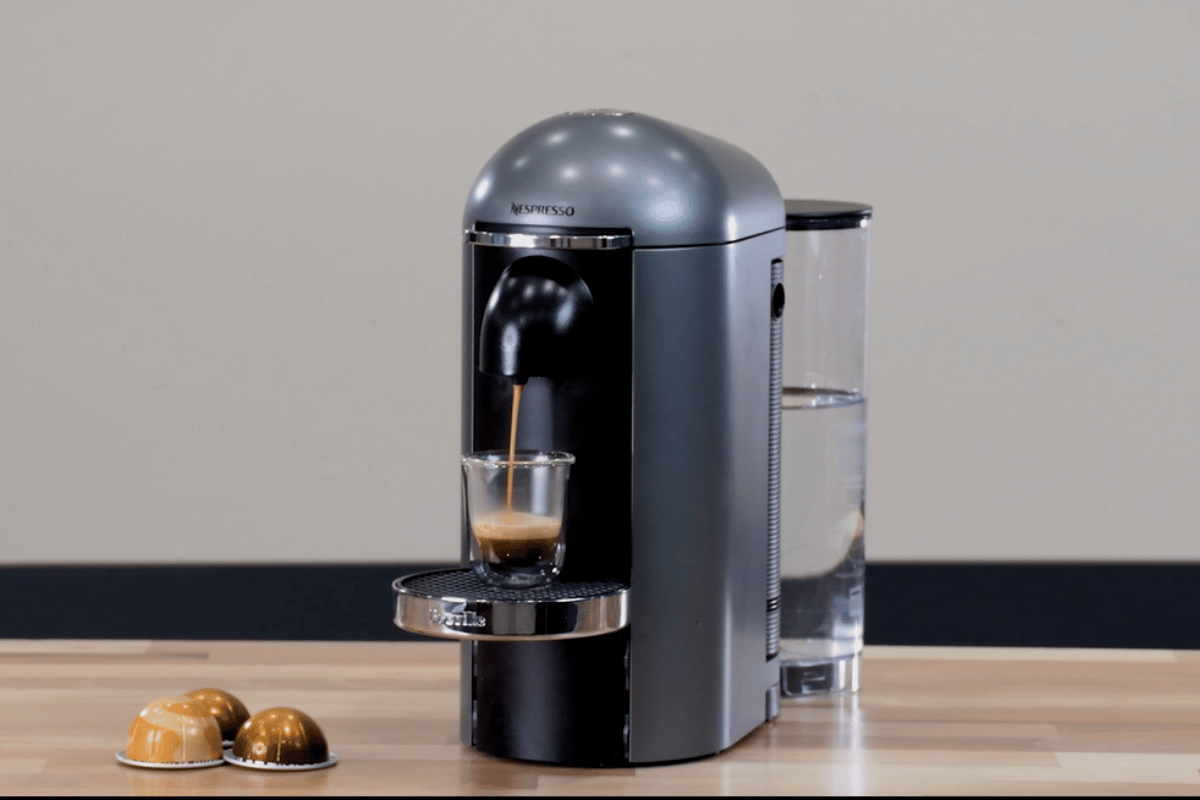
Each VertuoLine pod has a barcode, which the machine automatically reads and brews the drink accordingly. You don’t even have to press a button for a coffee drink (espresso, latte, etc.). The machine does it for you based on the barcode.
VertuoLine machines brew espresso or drip coffee-style drinks and are only compatible with VertuoLine capsules. Nespresso has a patent on VertuoLine pods, so third parties aren’t allowed to manufacture pods with their brand of coffee.
How Does it Taste?
Nespresso espresso flavor is a controversial topic. Does Nespresso brew a good espresso? I think Nespresso brews a decent shot. It’s less intense than regular espresso, and the flavors are a little muted. I describe it more as a “strong coffee” than a true espresso.
It doesn’t reach the same heights of flavor you get from a traditional espresso machine. However, you also don’t have any frustration, as there’s no way to mess up the brewing process. It’s great if you want a quick espresso and works great with milk, so I like using it to make lattes when I’m in a hurry.
Overall, the Nespresso shot has a medium body, rich flavor, moderate aromas, and some acidity. It’s less intense compared to espresso from a regular espresso machine. But, it’s noticeably stronger compared to dark drip coffee.
About Nespresso
Nespresso is part of Nestle Group corporation, based in Switzerland. Nespresso got its name from the combination of espresso and Nestle.
Eric Favre, a Nestle employee, was tasked with making a machine that combines Italian espresso with the convenience of domestic coffee in 1975. He got his inspiration from a coffee shop in Rome, which pumped the espresso machine lever several times instead of just once. This ensured their espresso had more air and water, resulting in a richer crema.
Favre came up with the first Nespresso machine in 1986. Initially, the machine didn’t take off. The history gets a little complicated following the launch, but within a few years, the device was modernized to what we know today, and the Nespresso brand moved upscale, eventually starting the George Clooney ads we’ve all seen, and…the rest is history. Millions of machines have been sold worldwide.
Nestle has three coffee capsule factories in Switzerland, and all pods come from one of these factories. The company sells coffee pods and machines worldwide. Today, Nespresso is found in 500 cities over the world. The brand has its own Nespresso capsule shops and cafes where you can walk in and get a brew from Nespresso capsules.
Espresso Overview
How Does the Machine Work?
There are three kinds of espresso machines: super-automatic, semi-automatic espresso machine, and manual espresso machine. These machines use coffee beans, not pods, and work by forcing hot water through a puck of finely ground coffee beans.
A super-automatic espresso machine is also called a bean-to-cup. It brews coffee with a press of a button. The machine takes care of grinding, tamping, and brewing. Regarding how much work is required on your part, it’s similar to Nespresso machines — you press a button, and the machine makes coffee.
A semi-automatic espresso machine requires a lot more work to learn but gives you much more control over the final product.
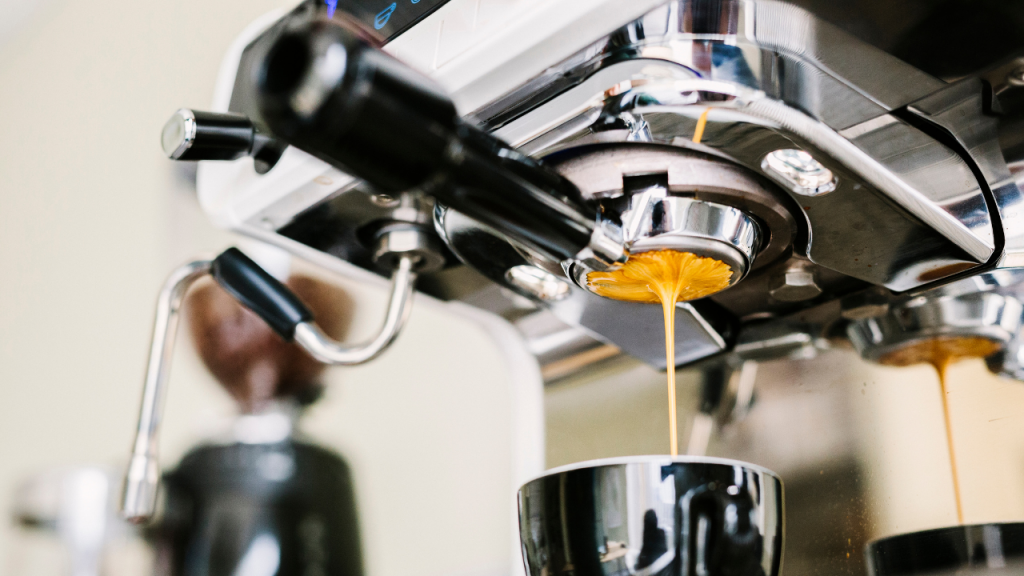
There’s a lot to the brewing process with a semi-automatic espresso machine. First, you have to get the correct grind size. Then, you have to distribute the grounds in the filter basket and tamp down the puck correctly.
You need to get this right so water doesn’t flow too slowly or too quickly. You also want to avoid common puck issues, such as channeling, where the coffee finds a way through the puck and doesn’t go through all grounds evenly.
Then you attach the portafilter to the brew head. You also decide the coffee-to-water ratio and brewing time to ensure there’s an even extraction.
The workload is on you, but the potential is high. Once you perfect your technique, you’ll love having control over the brewing process, and you’ll have high-quality shots.
How Does it Taste?
Regular (or proper) espresso has more body, is more intense, has bolder flavors, and a bigger acidic punch compared to Nespresso.
More importantly, there’s a lot more variance in flavor from traditional espresso. Since there’s so much room to change the inputs, there’s a lot of room to get different flavors. That can be great, but it can be inconsistent.
Espresso taste from a regular machine is richer, but it’s contingent on your experience and skill.
Nespresso vs. Espresso: What’s the Best Espresso Coffee Machine for You?
If you want convenience, have a small budget and little counter space, and want a quick caffeine fix, go for a Nespresso machine. If you’re an experienced barista with more budget, countertop space, and want a more flavorful espresso, choose a real espresso machine.
If you want to learn more about Nespresso coffee makers, check out our full Nespresso machine comparison.

